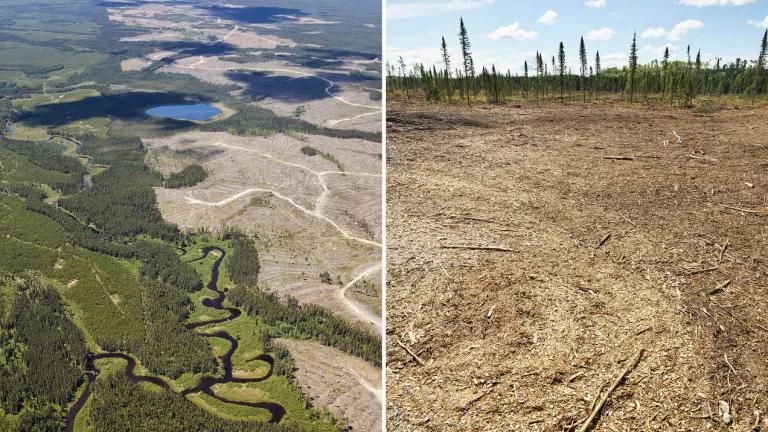Climate Chaos: California Wildfires Endanger Millions

As the Golden State fights catastrophic wildfires, we cannot lose sight of the human health toll.
Like many Americans, we’re horrified by the devastating and deadly wildfires burning across California. On the heels of the state’s deadliest and costliest wildfire season in its history just last year, these fires are a harrowing reminder of the dangerous future we’re facing due to accelerating climate change.
Our Climate Crisis Fuels Stronger Fires
Climate change and expanding urban development in fire-prone areas are putting more Californians in the path of dangerous wildfires over longer periods of the year. As temperatures rise, seasonal rainfall patterns change, and soil and vegetation moisture decline, the wildfire season in the western United States is growing more severe. The annual area burned by wildfires in California increased by 500 percent between 1972 and 2018—a trend that will only get worse as the state gets hotter and drier.
Fires Trigger Dangerous Health Problems
Wildfires pose numerous threats to public health, including to people directly in harm’s way and for millions more exposed to toxic air pollutants in wildfire smoke, which can affect areas hundreds of miles downwind.
An NRDC study found that in 2011, the area affected by wildfire smoke in the United States was nearly 50 times larger than the area burned directly by fires. That’s worrying, because wildfire smoke contains many health-harming contaminants, including fine particulate matter (PM 2.5)—one of the deadliest air pollutants known to humans. Breathing wildfire smoke is linked to a whole host of major health problems, such as respiratory infections, cardiac arrest, lung cancer, stroke, low birth weight, mental health conditions, and exacerbated asthma and chronic obstructive pulmonary disease. The more scientists study this air pollutant, the more health risks they are continuing to discover.
Wildfires are worsening California’s already serious and enduring struggles to reduce outdoor air pollution, with more than 19 million residents living in areas that exceed federal limits mandated by the Clean Air Act. Air quality in the United States worsened in 2018 after years of improvements, in part due to the growing problem of wildfire smoke.
Serious and Costly Health Toll
In our recent GeoHealth study, our coauthor team highlighted wildfire impacts on human health and shed new light on fire-linked health costs in Washington and Colorado during 2012. We’ve also recently analyzed the recent fire-fueled damage in Oregon.
To better understand the scale of ongoing wildfire-inflicted health risks in California, NRDC did further analysis. In 2012, an estimated 7,950 wildland fires burned more than 860,000 acres in California, according to the National Interagency Fire Center. To come up with health impact and health cost estimates for California, the team analyzed state-level data from a cutting-edge study estimating wildfire smoke–attributable health impacts across the United States. In that study, air quality and health researchers, led by scientists at the U.S. Environmental Protection Agency, combined wildfire smoke exposure estimates with the best available public health science to estimate the annual health effects of smoke exposures (early deaths and hospital admissions for respiratory and cardiovascular diseases).

Wildfires impose enormous health costs. Our coauthor team estimates that in 2012, wildfire smoke alone in California caused 693 premature deaths. Beyond that toll, the smoke triggered an estimated 4,690 emergency room visits and 375 hospital admissions for lung and heart problems. Using the same health cost valuation methods as we applied in our new GeoHealth study, the health damages linked to 2012 wildfire smoke in California totaled $6.5 billion (2018 dollars). That includes the costs of lost lives, medical care in emergency rooms and hospitals, prescribed medications, outpatient care needs, and lost wages.
With climate change increasing wildfire risks, our estimates indicate that wildfires in recent years, including the devastating fire seasons of 2017 and 2018, have taken a sizable toll on public health, adding billions in health costs. These health costs have been almost completely absent from public analyses of the economic damage wrought by wildfires.
Our GeoHealth study also identified disproportionate health risks for Medicare and Medicaid patients from wildfire-triggered illness. That finding aligns with our understanding that older adults and the economically disadvantaged are among those most vulnerable to the health effects of climate-sensitive events. People especially sensitive to PM 2.5 and other wildfire-generated air pollution exposures include children, older adults, pregnant women, people with preexisting cardiopulmonary disease, economically disadvantaged people, and those with preexisting chronic inflammatory conditions like diabetes and obesity.
Mental Health Problems Linger
The high health costs linked to wildfires are likely underestimates because they leave out other serious suffering caused by wildfires, including effects on mental health. We’ve seen that damage to homes, forced relocation, missed work time, and the loss of loved ones can lead to severe stress, depression, and unhealthy coping behaviors like drug use. While anyone can suffer short-term mental health issues from wildfires, economically disadvantaged people, people who already live with mental illness, and children are especially sensitive. Six months after the Camp Fire, the Butte County Office of Education had more requests from schools than they could fill for mental health support.
More severe fire seasons may also increase mental health problems among first responders, who tend to have a high prevalence of mental health conditions such as anxiety, post-traumatic stress disorder, and sleep disturbances. Nationally, wildland firefighters already seem to be at greater risk for suicide than non-wildland firefighters, and 46 fire responders in California have died by suicide in the last five years. As wildfire season grows longer, the mental, physical, and emotional demands (and accompanying health risks) placed on firefighters and other first responders will only increase.
Staying Safe
The Centers for Disease Control and Prevention has assembled a list of tips to decrease health risks from wildfires. These include:
- Preparing for fires: Confirm community evacuation plans and gather emergency supplies. Consider purchasing a respirator to reduce smoke exposures, but make sure it fits well.
- Evacuate if advised: Monitor the news to learn about current evacuation orders. Follow the instructions of local officials about when and where to evacuate.
- Check local air quality: Listen and watch for news or health warnings about smoke.
- Protect yourself during fire cleanup: Be aware that cleanup work can expose you to ash and other toxic fire remnants that may irritate the eyes, nose, lungs, or skin.
The EPA released an updated wildfire smoke guide this summer to help inform the public about these health risks and health-protective strategies to consider during wildfire events.
Addressing California’s Fire Woes
The sweeping extent of human misery caused by wildfires in California in recent years makes it clearer than ever that we must better equip communities to prepare for the many physical and mental health harms that wildfires inflict. To prevent even more suffering in the years to come, we’ve got to take the climate warning seriously and implement ambitious actions to slow global climate change that will save lives and dollars.
For more on our work to illuminate the high health costs of climate change, see the resources on this page.




